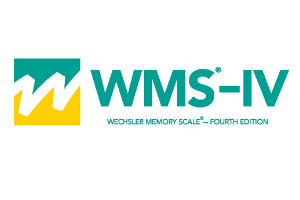Read about the new Flexible Approach!
In recognition of emerging demographic and clinical trends, the WMS—IV was developed to provide you with the most advanced measure of memory and results you can trust when addressing the changing clinical landscape.
Responding to influencing factors:
Changing Demographics
- Updated normative data for ages 16-90 years
- Enhanced utility for older adults
Emerging Clinical Needs
New Research in the Field
- Newly developed subtests and items
Increase Caseload
- Reduced administration time to obtain composite scores
- Improved scoring rules
4 Revision Goals
- Expanded clinical utility
- Enhanced user-friendliness
- Improved psychometric properties
- Updated test structure
Features & Benefits
Expanded Clinical utility
- Improved floors across subtests
- Included a general cognitive screening tool
- Enhanced assessment of visual memory
- Co-normed with the Wechsler Adult Intelligence Scale®-IV
Enhanced User Friendliness
- Included a brief older adult battery
- Reduced subtest administration time
- Minimized visual motor demands
- Assessed working memory
- Modified story content and administration process
Improved Psychometric Properties
- Updated norms
- Improved floors
- Improved subtest and composite reliability
- Reduced item bias
Areas of Assessment
Updated Test Structure
The WMS-IV has had significant changes to the overall test structure. Based on feedback from customers, we are introducing four new subtests and modifying three existing subtests.
4 subtests were added:
- Spatial Addition
- Symbol Span
- Design Memory
- General Cognitive Screener
3 subtests retained with modifications:
- Logical Memory
Although the stories remain the same as seen in WMS-III for ages 16-69 years old, the repetition trial for Story B has been dropped to increase the consistency with previous editions. For the older age range of 65-90 years old, a new story was developed with content more relevant. The story is shorter and repeated once to enable adequate floor through age 90. You can obtain immediate versus delay and recognition versus delay contrast scores.
- Verbal Paired Associates
It now includes a combination of difficult and easy items. For the younger age group (16-69 years) there are 14 items of which 10 are hard. For the older age group (65-90 years), there are 10 items of which six are hard. Delayed Free Recall Trial has been added while Recognition Trial has increased its level of difficulty. You can obtain immediate versus delay and recognition versus delay contrast scores.
- Visual Reproduction
While following the same structure and format as seen in WMS-III, there have been a few changes to the subtest. Recognition Trial has been shortened and scoring has been improved. Based on Munro Cullum’s research, scoring is easier and faster than previously experienced and emphasizes recall with less focus on drawing accuracy. You can obtain immediate versus delay and recognition versus delay contrast scores.
8 subtests were eliminated:
- Information & Orientation
- Spatial Span
- Mental Control
- Faces
- Digit Span
- Family Pictures
- Letter Number
- Word List (CVLT-II can be entered into Index)
What’s New
Spatial Addition
Based on “N-Back Paradigm”, Spatial Addition requires minimal motor function as the client must:
- Remember location of dots on two separate pages
- Add or subtract locations
- Hold and manipulate visual spatial information

Symbol Span
A “Visual analog to Digit Span”, clients are asked to remember the design and the left to right sequence of the design. The clients are then asked to select the correct design from foils and choose them in the correct sequence.

No more motor requirements
Design Memory
Containing four items of increasing difficulty, Design Memory evaluates immediate and delayed recall as well as delayed recognition. It does not include drawing and reduces the opportunity to guess the correct response. You can obtain scores for spatial, details, and correct content in the correct location as well as contrast scores for spatial versus detail, immediate versus delayed, and recognition versus delayed.

Obtain scores for spatial, details, and correct content in the correct location.
Cognitive Screener
This new screener can be used to quickly evaluate significant cognitive impairment. You can assess:
- Temporal orientation
- Mental control
- Clock drawing
- Memory
- Inhibitory control
- Verbal productivity
Also available are classification tables that translate total scores into Average, Low, Moderately low, and Very low.
NEW!
WMS–IV Flexible Approach
For use with the WMS-IV kit, new materials and data are now available that enable more flexible assessment based on individual client needs and examiner preferences.
- New record form and corresponding normative data allow brief administration and generation of alternative memory indexes.
- Additional new record form and corresponding normative data enable administration of new supplemental subtests (Logos and Names). The subtests provide an alternative memory index that eliminates motor demands on clients.
- Applicable normative information is available for all current WMS–IV users at no charge via a software update for scoring and reporting software users or via an electronic norms disk for non-software users.
Read the WMS–IV Flexible Approach Information Sheet
The WMS-IV offers a number of subtest configurations that yield Immediate, Delayed, Visual and Auditory Memory Index scores. The combinations of subtests reflect the desire to reduce administration time and to address specific clinical situations (e.g., limited motor ability).

The Standard WMS-IV: This consists of the 7 primary subtests that comprise the full WMS-IV battery and provide coverage for all the memory indexes.
The OAA* Battery: The OAA battery was developed in the standard WMS-IV as a shorter battery for use with older adults ages 65 to 90. This battery configuration was made available for examinees ages 16 through 69 in the WMS-IV Flex. The OAA battery uses LM, VR, and Verbal Paired Associates (VPA) to derive Immediate, Delayed, Auditory, and Visual Indexes.
The LMVR and LMDE* Batteries:
Two shorter alternative batteries were developed: LMVR, consisting of Logical Memory (LM) and Visual Reproduction (VR), and LMDE, consisting of Logical Memory and Designs (DE). LM and VR are the most frequently used subtests in the previous editions of the WMS and provide coverage for all the memory indexes. The second configuration of LM and DE retains the
content coverage with reduced motor demands.
The VRLO and LONA Batteries:
The last set of alternate batteries focuses on using supplemental subtests for assessing visual memory, which is a difficult construct to measure. During the development of the WMS-IV, two additional memory subtests were created: Logos (LO) and Names (NA). These two subtests provide optional measures of visual memory with the understanding that auditory memory functioning will also affect performance on these tests.
*LMDE and OAA batteries can be collected using standard WMS-IV record forms and an accompanying worksheet provided in the WMS-IV Flexible Manual.
- Scores are now derived for Older Adult Battery (65–90) and Adult Battery (16–69)
- Ability / Memory Discrepancy Scores (for use with WAIS–IV)
- Index Scores
- Auditory Memory
- Visual Memory
- Visual Working Memory
- Immediate Memory
- Delayed Memory
- NEW – Contrast Scores (PPT – 268 KB)
- Scaled scores contrasting performance across scores
- Provide information on clinical significance of changes in scores across subtests or indexes
WMS-IV Scoring Assistant
View a sample copy of the Scoring Report to accompany WMS-IV
View System Requirements.
WMS-IV Report Writer
- Click here for a sample interpretive report from the WMS-IV Report Writer (male/21 years)
- Click here for a sample interpretive report from the WMS-IV Report Writer (female/62 years)
View System Requirements.
Q-global Unlimited-use Scoring Subscriptions
Two pricing options are now available for scoring and reporting on Q-global. In addition to the current per-report price, there is now an unlimited-use scoring and reporting subscription available in one-, three-, and five-year terms.
Important note: Each subscription is per user for the WMS-IV only and will begin on the date of order processing unless otherwise requested.












